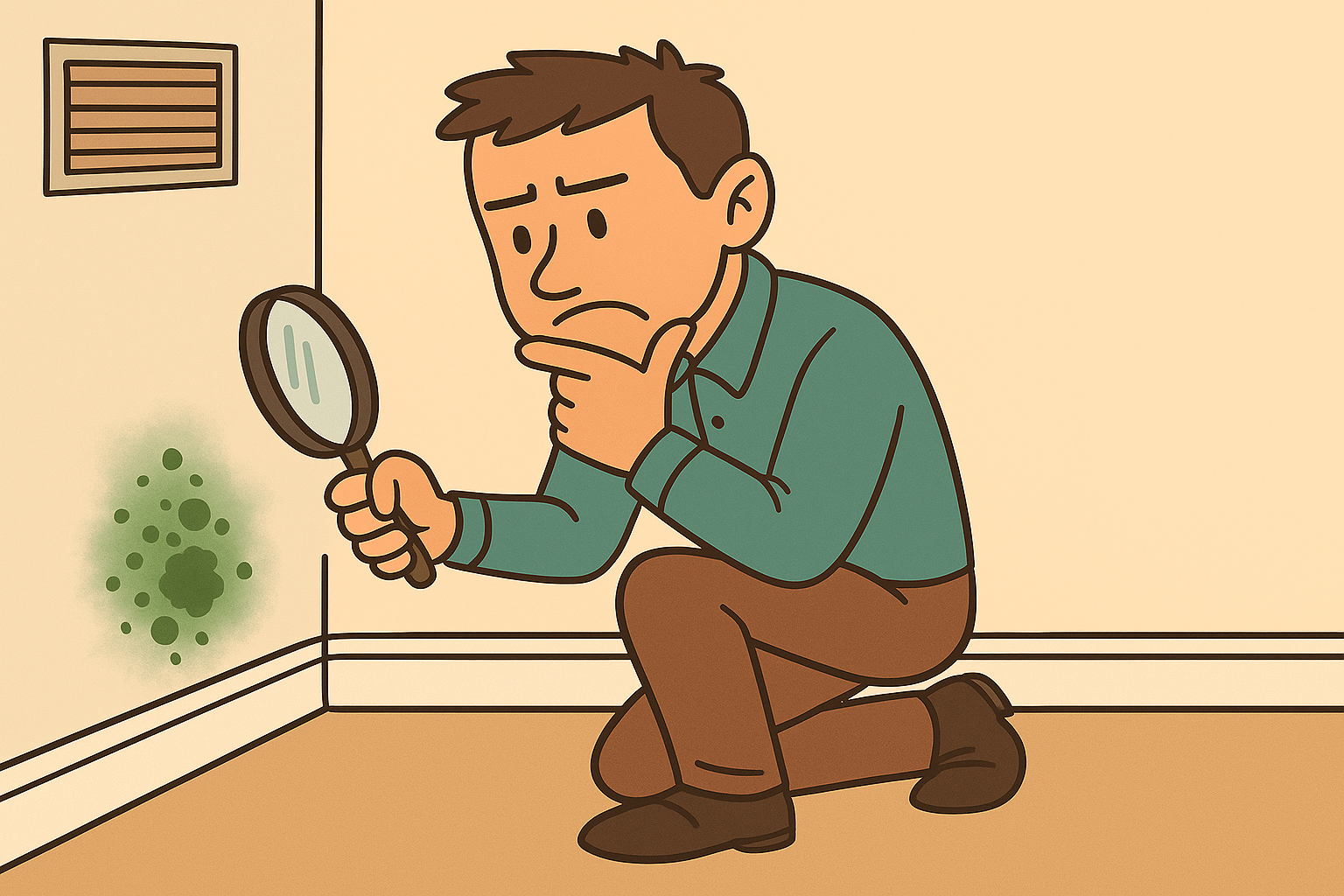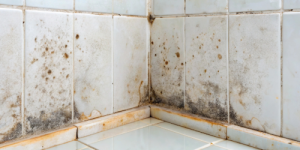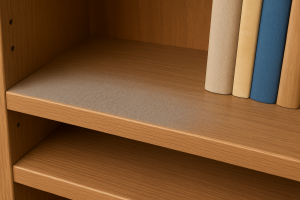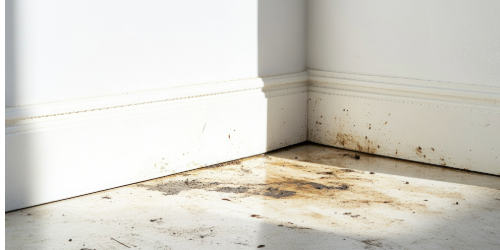
You spot a strange patch near a vent. At first glance, it looks like a little dirt or maybe dust that built up over time. But then you notice it’s spreading. Now you’re wondering, could this actually be mold?
Knowing the difference between signs of mold vs dust or dirt can help you catch a problem before it gets worse. Mold isn’t just a cosmetic issue. It can affect your indoor air quality, trigger allergies or asthma, and even damage walls, floors, and belongings if left untreated.
So how can you tell what you're really looking at?
Start with visual clues. Dust and dirt usually sit loosely on the surface and wipe away easily. Mold, on the other hand, often has a fuzzy or slimy texture. It may be black, green, white, or even orange. It often shows up in damp places like bathrooms, near windows, around HVAC vents, or on walls where moisture lingers.
Pay attention to how your body reacts. If you experience sneezing, coughing, itchy eyes, or headaches that seem worse at home, it might not be “just allergies.” Mold exposure can cause ongoing symptoms, especially for those with asthma or weakened immune systems.
Prevention matters too. Mold thrives in moisture, so reducing humidity, fixing leaks quickly, and using ventilation in kitchens and bathrooms can go a long way. Dust, while annoying, doesn’t grow or spread the way mold does.
If you’re unsure, don’t ignore the signs. Mold can start small but become a bigger issue fast.
By learning the early signs of mold vs dust or dirt, you can take smarter steps to protect your health and your space—before the damage is done.
Why It Matters: Mold vs. Dust Isn’t Just Cosmetic
When you see a dark smudge on your ceiling or wall, it is easy to brush it off as dust or dirt. However, ignoring the early signs of mold in a house can have real consequences, especially for renters, students, or anyone living in shared or older housing.
Mold is not just a cosmetic issue. It can release microscopic spores into the air that trigger health problems, especially for those with asthma, allergies, or weakened immune systems. Even in healthy people, mold exposure can lead to coughing, sneezing, brain fog, skin rashes, and ongoing fatigue. If mold is growing behind walls or under carpets, the health effects can build up without you realizing why you feel worse at home.
Misidentifying mold as dust can delay action. That delay gives mold time to spread. What started as a small patch in the corner can turn into a widespread issue that affects multiple rooms and becomes harder to clean up. For renters, that delay can also mean more damage to your belongings and difficulty getting repairs handled by your landlord.
At Mold Safe Living, we know what it is like to ignore the early signs. In our founder’s first apartment, what looked like dirt near the baseboards turned out to be mold creeping in after a slow leak. By the time it was confirmed, the health symptoms were already causing missed days of work and constant sinus trouble.
If you live in a dorm, rental apartment, or any place where moisture builds up, do not assume it is “just dust.” Learn what signs of mold in a house really look like. Acting early can protect your health, save your stuff, and give you the confidence to speak up when something feels off.
Visual Signs: How to Tell the Difference by Sight
You notice black spots on a wall or strange smudges near a vent. Your first thought might be, “Is it mold or dust?” Knowing what mold looks like and how it compares to dust or dirt can help you take the right action quickly.
Here’s a breakdown of how to spot the difference using appearance and location. Visual clues can be your first warning sign.
Mold
Appearance:
Black, green, gray, white, or even orange
Can look fuzzy, slimy, or patchy
May grow in clusters or spread in irregular shapes
Common Locations:
Bathrooms and kitchens
Around windows or AC vents
On ceilings, walls, or inside closets near plumbing

Dust
Appearance:
- Gray or light brown
- Looks soft or powdery
- Easily wipes away with a cloth or swipe of the finger
Common Locations:
- On bookshelves, electronics, or picture frames
- Along baseboards or corners of low-traffic rooms
- HVAC filters or fan blades

Dirt
Appearance:
- Brown, gritty, or muddy
- May appear in streaks or smudges
- Often tracked in from shoes
Common Locations:
- Near entryways or baseboards
- On floors near doors
- Around shoes or pet areas

Knowing what mold looks like is more than just a cleaning issue. Mold often signals a moisture problem that can grow into a health hazard if left untreated. Dust and dirt are surface-level nuisances. Mold spreads and releases spores.
If you are seeing black spots on a wall or unusual patches in damp areas, do not ignore them. Use sight as your first clue—and when in doubt, act fast. Recognizing early signs can protect your space and your health.
Smell Test: Mold Smells Musty
You walk into a room and something smells... off. It is not garbage, it is not dirty laundry, and it is not food. It smells damp, earthy, and strangely like a basement. If that scent lingers, you might be smelling mold.
Understanding how to know if it is mold can sometimes start with your nose. Mold releases something called microbial volatile organic compounds (MVOCs). These are gases created during the mold's growth process, and they are often responsible for that musty, stale odor people associate with basements or water-damaged areas.
Dust, on the other hand, usually has no scent at all. You may sneeze when it is stirred up, but dust itself does not carry that telltale “wet sock” or “old wood” smell that mold often gives off.
What to Look and Sniff For:
| Type | Appearance | Location |
|---|---|---|
| Mold | Green, black, fuzzy, or slimy | Near moisture, vents, under sinks, bathrooms |
| Dust | Gray, soft, easily wiped | On furniture, shelves, unused corners |
| Dirt | Brown, gritty, streaky | By baseboards, entryways, around shoes |
If you notice a musty odor and it keeps coming back—even after cleaning—it is a good idea to check areas where moisture collects. Bathrooms, laundry rooms, under sinks, and HVAC vents are common mold spots. Air purifiers can help with temporary odor relief, but they will not fix the root cause. Mold needs moisture to survive. If you do not control the humidity or address leaks, the smell and growth will return.
For renters or anyone in shared housing, knowing how to identify mold by smell can help you catch it early, even before you see visible signs. Trust your nose. If the air smells like an old basement and you are not in one, it may be time to investigate further. Knowing how to know if it is mold could be the first step in protecting your health and living environment.
Also Read: Mold Glossary of Terms
Surface Test: What Happens When You Wipe It?
You see something suspicious on your wall. It could be mold or dirt—or maybe just a patch of dust. One easy way to figure it out is by doing a simple wipe test.
Grab a dry or slightly damp cloth and gently wipe the area. What happens next can give you important clues about what you are dealing with.
If It’s Dust:
Dust wipes away easily. It will leave your cloth looking gray or powdery, and the surface underneath should look clean afterward. Dust is dry, soft, and typically found on shelves, furniture, or untouched corners. No stain is left behind once it is gone.
If It’s Dirt:
Dirt tends to smudge. It is often gritty or muddy in texture and may leave a streak or stain when you wipe it. However, it usually feels dry and does not spread beyond the original spot. Dirt is often found near baseboards, doorways, or places where shoes and pets pass through.
If It’s Mold:
Mold behaves differently. When you wipe mold, it may smear, spread, or even stay stuck. Some mold may leave behind a colored stain—green, black, or brown—and not come off entirely, even with cleaner. Mold that will not wipe off often means it has taken root in the surface. It may feel slimy or damp and is usually found near moisture-prone areas like bathrooms, windows, or near vents.
This is why knowing how to identify mold or dirt on walls matters. Mold is a living organism that grows when moisture is present, while dirt and dust are typically non-living and more superficial.
If you try to wipe a spot and it smears oddly or leaves discoloration behind, you might be dealing with mold that will not wipe off. In that case, cleaning is only part of the solution. Moisture control and deeper inspection may be needed to stop it from coming back.
The surface test is a simple way to start—but what happens after the wipe matters just as much.
When It’s Time to Get Help
Not every mold problem can be solved with a spray bottle and a scrub brush. While small spots of surface mold in the shower or around a window might be manageable on your own, some situations call for more than just cleaning. Knowing when it is time to get help can protect your health, your belongings, and your peace of mind.
So how do you know the issue has gone beyond DIY?
1. The stain keeps coming back
If you clean a spot and it returns within days or weeks, there may be a deeper moisture problem behind the wall, under the floor, or inside the ceiling. Mold feeds on damp surfaces. If the moisture is not addressed, the mold will continue to grow—often out of sight.
2. It is spreading to multiple rooms
One patch of mold in a bathroom is common. But if you start noticing spots in different rooms, especially in areas not known for moisture you could be dealing with a larger problem. Mold spores travel through the air and may spread through vents or shared wall cavities.
3. You are experiencing ongoing symptoms
Coughing, sinus pressure, headaches, fatigue, or skin irritation that worsens at home can all be signs of mold exposure. If symptoms improve when you leave the space and return when you come back, it may be time to look beyond basic cleaning.
4. There is a strong musty smell you cannot trace
If your space smells like a basement and you cannot find a source, mold may be growing behind walls or under flooring. You may not see it, but your nose knows something is not right.
Sometimes, getting help means asking your landlord to investigate. Other times, it means calling in professionals who can test and confirm the issue. If mold is affecting your health or your space in a way that keeps getting worse, do not wait. Mold problems are easiest to handle when caught early—and hardest to ignore once they take hold.
Conclusion
Mold often starts small. A patch in the corner, a faint stain by the window, or a musty smell you cannot quite place. It is easy to overlook or mistake it for something harmless like dirt or dust. But what seems minor at first can lead to bigger problems for your health, your home, and your peace of mind.
The truth is, mold does not need much to grow. A little moisture, limited airflow, and time are all it takes for it to spread. And once it does, it becomes harder to clean, costlier to fix, and more likely to cause symptoms that interfere with daily life.
You do not need to panic at every smudge, but you do need to stay aware. Learning to recognize the early signs of how it looks, smells, and reacts when wiped can help you catch it before it gets out of control. Knowing how to tell the difference between mold, dirt, and dust can give you more confidence when something does not feel right.
If something keeps coming back after cleaning, if you feel worse at home than you do elsewhere, or if the smell lingers even after deep cleaning, trust your instincts. Mold that hides behind walls or spreads from room to room is not something to ignore.
When in doubt, test and take action. Whether that means checking for leaks, running a dehumidifier, or getting a second opinion, doing something is always better than doing nothing. Mold problems rarely get better on their own.
At Mold Safe Living, we believe renters, students, and families deserve safe spaces to breathe and live comfortably. Mold can look like a small issue, but its impact can be anything but small. Stay informed, stay alert, and do not hesitate to act when the signs are there.
